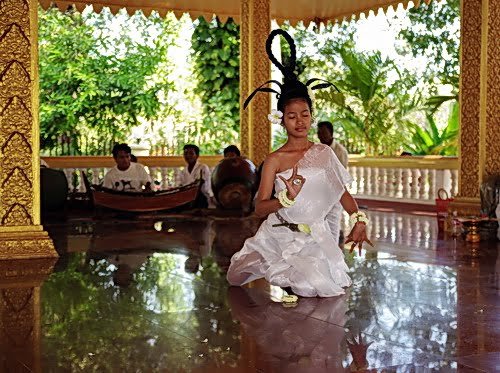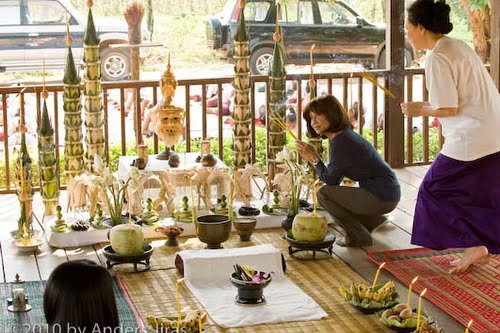Tiny Dancers of Banteay Srey

“Tiny Dancers of Banteay Srey” by Aye Sapay and Cherry Thein © 2010 The Phnom Penh Post This article appears with the permission of the copyright holder. No further reproduction is permitted.
Siem Reap, Cambodia – Fourteen young Khmer girls, dressed in flowing white garb with coconut flowers in their hair, danced sinuously to the rhythm of traditional classical music. The Preah Ang Chiek Preah Ang Chhorm Shrine in Siem Reap, next to the Royal Residence, was the venue enlightened by their sashays.
As the girls went through their paces on the evening of January 26, a growing band of lucky tourists gathered, gob-smacked, to watch this ritual unfold. The looks of delight on the crowd’s faces proved they knew they were seeing something special, but of course they were unaware of the significance of the proceedings.
They were unaware that the shrine where the ritual was taking place was the most sacred site in Siem Reap and that the images of the divinities within the shrine are considered the most powerful in the town.
They were unaware, too, that the ritual was unfolding in the presence of royalty and that two of the three women sitting on a prayer mat among the dancers were princesses, including one of Cambodia’s most legendary classical dancers, Her Royal Highness Princess Buppha Devi, and her daughter, Princess Norodom Sisowath.
The third woman was the “mother” of the tribe of little dancers, Lady Ravynn Karet-Coxen, although she was quick to say, “You can drop the lady bit and just call me Ravynn Karet-Coxen as it is more in tune with the work I do with the most destitute, thank you.”

The dancing girls were part of a troupe of more than 160 children who had been lovingly trained by Ravynn Karet-Coxen, the founder of the Nginn Karet Foundation for Cambodia (NKFC) Conservatoire Preah Ream Bopha Devi dance school, of which Coxen is chairperson.
Princess Buppha Devi, the patron of the school, had come to the sacred shrine on the evening of January 26 to partake in the ritual and to pray for the good health of King Father Sihanouk and King Sihamoni, to pray for the government so that it can lead the country well, and to pray to the dance divinity and the dance spirit of ancient Angkor.
But more importantly, the ritual at the shrine was the culmination of a day of celebration marking the third anniversary of the Royal Patronage of Ravynn Karet-Coxen’s dance school at nearby Banteay Srey; the first and only arts school in the Angkor Archaeological Park and the only school of its kind in the Kingdom.
The onlooking tourists were lucky to see the performance because usually the dancers are hidden and protected from the prying eyes to “preserve their purity” as Ravynn Karet-Coxen put it.

he said her school was not intended to train dancers to entertain people for money.
She proclaimed the dancing taught in her school helps the children learn to respect their god and divinities, and explained that the little dancers usually perform in temples and sacred areas for the gratification of the Gods and the King. Last year the dancers performed their first royal private performance for the king’s birthday.
She added that her dancers are never allowed to wear heavy costumes, jewellery or make-up on their faces, like the so-called traditional dancers who perform in public for tourists. Her dancers are also instructed to dance in bare feet on Mother Earth or on simple mats, and not on stages.
“We do not dance for entertainment or money,” Ravynn Karet-Coxen emphasised. “And certainly not to amuse tourists in the hotels. We don’t need that. We are dancing for our God.”
Rural students attend the school at no cost to their families, who live below poverty level. In 2010, NKFC initiated a program enabling supporters to sponsor young dancers and musicians. The cost is only $5 per week but even that small amount of money will change a child’s life and future.
Special thanks to photographer Anders Jiras for sharing his images for this article.
